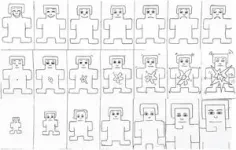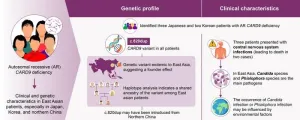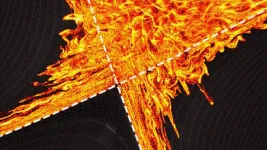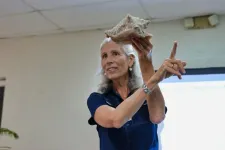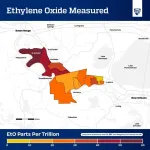(Press-News.org) WASHINGTON, June 11, 2024 – Today’s intelligent robots can accurately recognize many objects through vision and touch. Tactile information, obtained through sensors, along with machine learning algorithms, enables robots to identify objects previously handled.
However, sensing is often confused when presented with objects similar in size and shape, or objects unknown to the robot. Other factors restrictive to robot perception include background noise and the same type of object with different shapes and sizes.
In Applied Physics Reviews, by AIP Publishing, researchers from Tsinghua University worked to break through the difficulties of robotic recognition of various common, yet complex, items.
Humans possess many different types of touch sensing, one of which is thermal feeling. This allows us to sense the wind blowing, perceive hot and cold, and discriminate between matter types, such as wood and metal, because of the different cooling sensations produced. The researchers aimed to mimic this ability by designing a robotic tactile sensing method that incorporated thermal sensations for more robust and accurate object detection.
“We propose utilizing spatiotemporal tactile sensing during hand grasping to extend the robotic function and ability to simultaneously perceive multi-attributes of the grasped object, including thermal conductivity, thermal diffusivity, surface roughness, contact pressure, and temperature,” said author Rong Zhu.
The team created a layered sensor with material detection at the surface and pressure sensitivity at the bottom, with a porous middle layer sensitive to thermal changes. They paired this sensor with an efficient cascade classification algorithm that rules out object types in order, from easy to hard, starting with simple categories like empty cartons before moving on to orange peels or scraps of cloth.
To test the capabilities of their method, the team created an intelligent robot tactile system to sort garbage. The robot picked up a range of common trash items, including empty cartons, bread scraps, plastic bags, plastic bottles, napkins, sponges, orange peels, and expired drugs. It sorted the trash into separate containers for recyclables, food scraps, hazardous waste, and other waste. Their system achieved a classification accuracy of 98.85% in recognizing diverse garbage objects not encountered previously. This successful garbage sorting behavior could greatly reduce human labor in real-life scenarios and provide a broad applicability for smart life technologies.
Future research in this area will focus on enhancing robotic embodied intelligence and autonomous implementation.
“In addition, by combining this sensor with brain-computer interface technology, tactile information collected by the sensor could be converted into neural signals acceptable to the human brain, re-empowering tactile perception capabilities for people with hand disabilities,” said Zhu.
###
The article “Enhanced robotic tactile perception with spatiotemporal sensing and logical reasoning for robust object recognition” is authored by Qian Mao and Rong Zhu. The article will appear in Applied Physics Reviews on June 11, 2024 (DOI: 10.1063/5.0176343). After that date, it can be accessed at https://doi.org/10.1063/5.0176343.
ABOUT THE JOURNAL
Applied Physics Reviews features articles on significant and current topics in experimental or theoretical research in applied physics, or in applications of physics to other branches of science and engineering. The journal publishes both original research on pioneering studies of broad interest to the applied physics community, and reviews on established or emerging areas of applied physics. See https://aip.scitation.org/journal/are.
###
END
Trash-sorting robot mimics complex human sense of touch
Tactile sensing and logical reasoning strategies aid a robot’s ability to recognize and classify objects.
2024-06-11
ELSE PRESS RELEASES FROM THIS DATE:
Shedding light on the origin of a genetic variant underlying fungal infections
2024-06-11
Researchers from Japan uncover the genetic diversity and regional patterns of CARD9 deficiency in patients susceptible to fungal diseases
Tokyo, Japan – Fungal infections pose life-threatening risks, especially when vital organs or the central nervous system are affected. Individuals harboring variants in the CARD9 gene are particularly susceptible to invasive fungal infections, given that the protein coded by this gene serves as a critical regulator of the immune system. A recent discovery ...
Humanitarian organizations showed flexibility and grit during COVID supply chain disruptions: study
2024-06-11
When the COVID-19 pandemic hit, it sent shock waves across global supply chains. But manufacturers and other businesses weren’t the only ones hit hard: local and international aid organizations, tasked with providing humanitarian assistance during times of crisis, suddenly had a major crisis of their own. How would they get the supplies they needed to carry out their crucial work?
According to a new study by the UBC Sauder School of Business, the organizations showed remarkable nimbleness and ingenuity — and while the pandemic was an unusual event, their approaches can provide powerful insights ...
Research on the visual rabbit illusion takes a leap forward
2024-06-11
Fukuoka, Japan—Researchers from Kyushu University have uncovered new variations to a traditional illusion, based on how we perceive the motion of flashing lights. Published on May 21 in i-Perception, the findings show that when three light flashes are presented in rapid succession in our side vision, our brain tends to perceive them in a straight line, with the second flash around the midpoint, no matter the actual location of the second flash. This research, which earned the journal’s Early Career Best Paper Prize this year, offers new perspectives on perceptual errors ...
Virus-like nanoparticles control the multicellular organization and reproduction of host bacteria
2024-06-11
Tsukuba, Japan—Viruses are ubiquitous in the environment, and organisms have developed various mechanisms to counter their threat. However, the genome of actinomycetes contains a highly conserved gene set encoding virus-like nanoparticles, although its biological significance has remained unclear.
In this study, researchers examined Streptomyces davawensis, an actinomycete species, and discovered that it produces virus-like particles that facilitate host reproduction. Extracellular DNA, which serves as a scaffold for multicellular organization, was significantly reduced in the colonies of mutant S. davawensis strains ...
Origins of fast radio bursts come into focus through polarized light
2024-06-11
TORONTO, ON, June 11, 2024 — What scientists previously thought about where Fast Radio Bursts (FRBs) come from is just the tip of the iceberg, according to new research led by astronomers at the University of Toronto. The mysteries of the millisecond-long cosmic explosions are unfolding with a new way of analyzing data from the Canadian Hydrogen Intensity Mapping Experiment (CHIME).
Published today in The Astrophysical Journal, the study details the properties of polarized light from 128 non-repeating FRBs — those from sources that have ...
Press registration opens for ACS Fall 2024
2024-06-11
WASHINGTON, June 11, 2024 — Journalists who register for the fall meeting of the American Chemical Society (ACS) will have access to about 10,000 presentations on topics including agriculture and food, energy and fuels, health and medicine, sustainability, and more. ACS Fall 2024 is a hybrid meeting being held virtually and in person in Denver on Aug. 18-22, with the theme “Elevating Chemistry.”
ACS considers requests for press credentials and complimentary meeting registration from reporters (staff and freelance) and public information officers at government, nonprofit and educational institutions. Please ...
New plasma escape mechanism could protect fusion vessels from excessive heat
2024-06-11
The furious exhaust heat generated by a fusing plasma in a commercial-scale reactor may not be as damaging to the vessel’s innards as once thought, according to researchers at the U.S. Department of Energy’s (DOE) Princeton Plasma Physics Laboratory (PPPL), Oak Ridge National Laboratory and the ITER Organization (ITER).
“This discovery fundamentally changes how we think about the way heat and particles travel between two critically important regions at the edge of a plasma during fusion,” said PPPL Managing Principal Research Physicist Choongseok Chang, who led ...
Endocrine Society urges passage of the Right to IVF Act
2024-06-11
WASHINGTON—The Endocrine Society endorses the Right to IVF Act, which was introduced by Senators Cory Booker (D-NJ), Patty Murray (D-WA) and Tammy Duckworth (D-IL) to protect and expand nationwide access to fertility treatment, including in vitro fertilization (IVF), and urges the Senate to pass the Right to IVF Act on June 12th to ensure that the freedom to start and grow a family is protected and accessible to everyone in the United States.
Infertility affects an increasing number of individuals. ...
FAU Harbor Branch launches ‘eConch’ to grow and conserve the queen conch
2024-06-11
The queen conch (Aliger gigas) is a prized delicacy long harvested for food and revered for its beautiful shell. With a lifespan between 25 to 40 years, the queen conch is second only to the spiny lobster fishery and is the most important molluscan fishery in the Caribbean region.
Deeply rooted in the way of life in the Caribbean, many island communities depend on queen conch for their livelihoods. However, intensive fishing and habitat degradation from urbanization and climate change have caused conch populations ...
Surprisingly high levels of toxic gas found in Louisiana
2024-06-11
The toxic gas ethylene oxide, at levels thousand times higher than what is considered safe, was detected across parts of Louisiana with a cutting-edge mobile air-testing lab. The concentrations found dwarfed Environmental Protection Agency estimates for the region.
The findings, led by Johns Hopkins University environmental engineers, suggest significantly higher cancer risks for people who live near facilities that manufacture and use ethylene oxide, as well as a need for more accurate and reliable tools to monitor emissions.
“I don’t think there’s any census track in the area that wasn’t at higher risk for cancer than we would deem acceptable,” said ...
LAST 30 PRESS RELEASES:
Numbers in our sights affect how we perceive space
SIMJ announces global collaborative book project in commemoration of its 75th anniversary
Air pollution exposure and birth weight
Obstructive sleep apnea risk and mental health conditions among older adults
How talking slows eye movements behind the wheel
The Ceramic Society of Japan’s Oxoate Ceramics Research Association launches new international book project
Heart-brain connection: international study reveals the role of the vagus nerve in keeping the heart young
Researchers identify Rb1 as a predictive biomarker for a new therapeutic strategy in some breast cancers
Survey reveals ethical gaps slowing AI adoption in pediatric surgery
Stimulant ADHD medications work differently than thought
AI overestimates how smart people are, according to HSE economists
HSE researchers create genome-wide map of quadruplexes
Scientists boost cell "powerhouses" to burn more calories
Automatic label checking: The missing step in making reliable medical AI
Low daily alcohol intake linked to 50% heightened mouth cancer risk in India
American Meteorological Society announces Rick Spinrad as 2026 President-Elect
Biomass-based carbon capture spotlighted in newly released global climate webinar recording
Illuminating invisible nano pollutants: advanced bioimaging tracks the full journey of emerging nanoscale contaminants in living systems
How does age affect recovery from spinal cord injury?
Novel AI tool offers prognosis for patients with head and neck cancer
Fathers’ microplastic exposure tied to their children’s metabolic problems
Research validates laboratory model for studying high-grade serous ovarian cancer
SIR 2026 delivers transformative breakthroughs in minimally invasive medicine to improve patient care
Stem Cell Reports most downloaded papers of 2025 highlight the breadth and impact of stem cell research
Oxford-led study estimates NHS spends around 3% of its primary and secondary care budget on the health impacts of heat and cold in England
A researcher’s long quest leads to a smart composite breakthrough
Urban wild bees act as “microbial sensors” of city health.
New study finds where you live affects recovery after a hip fracture
Forecasting the impact of fully automated vehicle adoption on US road traffic injuries
Alcohol-related hospitalizations from 2016 to 2022
[Press-News.org] Trash-sorting robot mimics complex human sense of touchTactile sensing and logical reasoning strategies aid a robot’s ability to recognize and classify objects.

